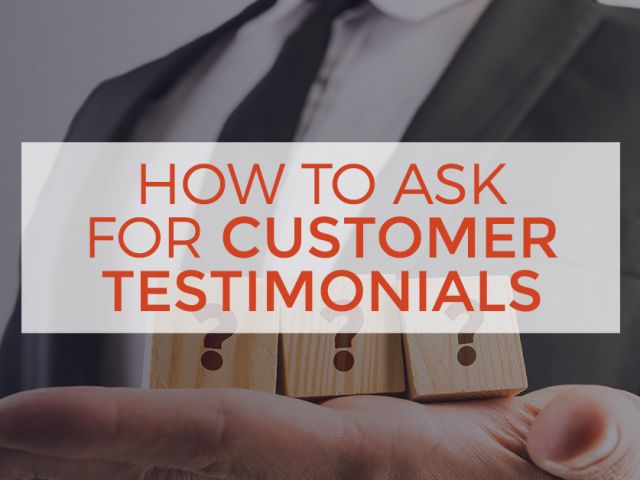Playbook
Customer Testimonials Videos: Build Trust & Close Sales
Video testimonials are one of the most valuable assets you can give a salesperson or marketer. Learn how we’ve helped dozens of businesses generate more revenue with customer testimonials.
1.
Testimonial Strategy & Planning
Before creating testimonial videos that help close sales, a little planning goes a long way in maximizing their potential.
You are here.
2.
Video Testimonial Production
Learn how to safely and swiftly create high-impact testimonial videos in a way that’s convenient for you and your customers.
3.
Getting Results with Testimonials
Get proven marketing and sales strategies for maximizing the value of your testimonials videos in the real world.
Introduction
Customer Testimonials

Your customers need to trust you before they will buy from you. Customer testimonials provide incredibly powerful social proof that demonstrates that your product or service delivers on its promises.
If you’re new to customer testimonials, start here.
Customer Testimonials: Frequently Asked Questions
What is a customer testimonial?
A customer testimonial is a peer recommendation from a satisfied customer that confirms to potential buyers of your product or service that it delivers on its promises. They are used by businesses, often by marketing staff and salespeople, to build trust with prospects and help close sales.
Customer testimonials take many forms, including a simple quote, customer reviews, and video testimonials, to name a few.
Why are Customer Testimonials Important?
Customer testimonials can help your business sell far more effectively than any first-party messaging you have about your products or services because they come from an unbiased source.
Testimonials build trust and credibility, through social proof, that your product or service actually works, and they help potential buyers imagine themselves in the shoes of a satisfied customer.
Why use video testimonials instead of written testimonials?
Customer testimonials, in any form, are highly effective marketing and sales tools. However, like most types of content, video testimonials are much more effective than their written counterparts because they enhance credbility, improve engagement and help potential buyers connect on a deeper, more emotional level with your already satisfied customers.
How do you use customer testimonials?
Customer testimonials can be used in many ways to establish credibility and drive revenue, including:
- Strategically placing them on your website
- Using them in marketing campaigns
- Using them in paid advertising campaigns
- Using them in sales efforts
Want to make customer testimonial videos work for your business?
Schedule a free consultation with a video expert, and learn how you can produce video testimonials quickly and cost-effectively.
Customer Testimonial Statistics
72% of consumers say customer testimonials increase their trust in a business.
97% of B2B businesses cited testimonials and recommendations from peers as the most reliable type of content.
88% of consumers trust online testimonials and reviews as much as recommendations from friends or family.
70% of people trust reviews and recommendations from strangers.
(Nielsen)
Section 1
Testimonial Strategy & Planning
Maximizing the sales and marketing results you get from customer testimonials requires a formal strategy for collecting testimonials, deciding what customer stories to tell, and coordinating with customers to deliver messaging that supports your business.

In this section of the video testimonial playbook:
- Why Video Testimonials?
- Develop a Strategy for Maximizing the Potential of your Video Testimonials
- How to Use Customer Testimonials
- How Many Testimonial Video Do You Need?
- Decide What Story You Want to Tell with Your Testimonials
- Which Customers Should You Ask for Testimonials?
- How to Ask Customers for Testimonials
- How to Get Great Customer Testimonials
- How to Get Video Testimonials from Customers
Why Video Testimonials?
Testimonials are already one of the most powerful tools available to marketers and salespeople, for their ability to build trust and overcome objections.
Video takes customer testimonials, product reviews and client case studies to a whole new level, by getting to the emotions that lie beneath the usage stories, success metrics, and satisfaction of typical written testimonials.
This guide will focus primarily on video testimonials (because they’re just so much more effective!), but many of these principles, tips and tactics can be applied broadly to customer testimonials.
Benefits of video testimonials:
- Testimonials build trust and credibility with your target audience, and video is able to capture the passion your customers have, and creates a deeper emotional bond with the viewer.
- Testimonials helps prospects understand how your product or service works in the real world, and video is able to demonstrate that value more clearly.
- Testimonials are great at converting leads into sales at the bottom of the funnel, and your ability to engage prospects and inspire action is even greater with video testimonials.
Develop a Strategy for Maximizing the Potential of Your Video Testimonials
The first step in using video testimonials effectively is clearly defining what you want to accomplish.
You know you want to close more business, but how?
- Do you want to produce more sales in particular verticals?
- Do you want more sales from specific buyer personas?
- Do you want to sell to existing customers?
Secondly, how will your videos be used?
- Will your videos be used on your website?
- Will you use your videos in marketing and ad campaigns?
- Will your testimonials be used by sales staff?

Your answers to these questions will help you determine who your video testimonials are intended for, what they should look like, and how to use them most effectively.
How to Use Customer Testimonials
You’ll learn specific tactics and strategies for using customer testimonial videos to close more sales in the Results section of this playbook, but here is an overview of ways testimonials are commonly used.
Marketing
The way business is done has changed dramatically over the last decade. Nearly 70% of research is done by before buyers ever reach out to a company or salesperson, according to Forrester Research. Video testimonials enable you to build deep levels of trust with prospects, before ever talking with them.
Sales
Businesses and consumers only buy from people and companies that they trust. With a library of video testimonials to draw from, your salespeople are equipped for every sales scenario, ready to help them establish immediate trust, overcome buyer objections and close deals.
Specifically, customer testimonials can be highly effective when used on a business website, social media, and in ad campaigns.
Website
A testimonial page is one thing, but strategically placing testimonials at key friction points on your website and landing pages, usually around bottom-of-funnel calls-to-action (subscribe, contact, pricing, buy, etc.) can have a profound effect on your conversion rates.
Social Media
Social media is a great medium for deepening relationships with your audience, and video testimonials are a highly effective way to inject social proof into your content, demonstrate the value of your product or services, increase trust with prospects, and garnerer engagement.
Ad Campaigns
Video ad campaigns featuring customer testimonials can be used throughout the marketing funnel to build trust and nurture prospects into customers. With precise targeting, video testimonials can be placed in front of buyers at just the right time, to accelerate the buying cycle and help close the sale.
Testimonials of any kind, whether a consumer rating, product review, social media post or otherwise, help you build trust through social proof, making them an incredible sales and marketing tool. However, video testimonials are by far the most valuable type of customer testimonial a business can have at its disposal – no matter how or where you use them.
How Many Testimonials Do You Need?
Like any other piece of marketing or sales collateral, video testimonials are most effective when they are relevant to the consumer of the content.
If your solution solves the same problem for all your customers, any testimonial they see will be relevant. However, if your solution solves different problems in different ways for different people, you have to make sure you’re video testimonials are relevant to their intended audience.
To demonstrate, imagine these scenarios:

Company A has a simple app that helps people find nearby parking garages.
Most users use the app in the same way and the value proposition is the same, so having a diverse group of people appear in their testimonials and talk about how satisfied they are with app is a pretty straightforward proposition.

Company B offers a solution that helps parking garage owners manage their properties.
The same solution is used in very different ways by different customers. Some have one garage, while others manage hundreds, and some have EV-charging, security, and a variety of other amenities to manage.
Different customers with different challenges require different solutions, so telling those customers’ very different stories is something you’re going to have to do if you wish to be relevant to the different types of customers you’re targeting and address their different experiences.
Customers need help imagining how they will use your solution to solve their particular problems. So, you’re going to need enough testimonials to be relevant to the various market segments you serve. Similarly, you’ll need to produce testimonials that demonstrate how your solutions are evolving to address challenges that have recently emerged.
When it comes to relevance, having enough customer testimonials to cover the various solution sets that you provide is paramount. But, there are other considerations that may affect the number of testimonials that you need.
For example, in some markets your geographic location is important to your customers, so you’ll want to make sure that your video testimonials cover the right geographies.
Demographic factors may also be important. Even though everyone may be using your solution in roughly the same way, having testimonials that represent companies of different sizes, business models, and other demographic features may be extremely important to prospective buyers in the markets you serve.

Decide What Story You Want to Tell with Your Testimonials
Now that you know which segments of your target audience you want your testimonials to appeal to, it’s time to figure out how to tell your customers’ stories in the most appealing way.
How you tell their stories, despite how closely you’ve matched their personas with those of your prospects, will have a great impact on your prospects ability to put themselves in the shoes of your customers, and ultimately, the effectiveness of your testimonial videos.
Customers want to feel like they’re in control of their own destinies, and not the lucky beneficiaries of your company’s genius and generosity.
By following the arc of the Hero’s Journey in your testimonials, your audience will be able to engage with your successful customers and see you as the mentor who makes it possible for them to complete their journey.

What is the Hero’s Journey?
The Odyssey, Star Wars, and a good customer testimonial all have one thing in common: they follow the path of the Hero’s Journey.
It’s the story arc for pretty much every epic hero, and it’s the story arc we look for when we imagine ourselves in the role of the hero. If you want your customers and prospects to engage deeply with your testimonial stories, you must make your customers – not your products and services – the heroes of those stories.
As the story begins, the hero’s normal life is interrupted by a previously unforeseen challenge, which the hero is likely to downplay or ignore.
Eventually, they understand that the challenge will not go away and that they must address it in order to survive and prosper.
Once they accept the challenge, the hero thrashes about looking for a solution, but nothing works.
Just as despair sets in, a mentor or guide appears, who points the hero in the right direction, and prepares them for the adventure ahead.
Armed with this insight, the hero successfully faces the many challenges ahead, and eventually returns to his normal life, enriched by what they have learned and accomplished.
Drafting out the stories you want your customer testimonials to tell will help you determine what questions you’ll ask your customers, in order to draw out answers that will help you tell that story.
You can’t change your customers’ stories, and having them read off a script usually sounds robotic and often lacks credibility, so you won’t have complete control over what story they want to tell, but preparing the right questions can greatly influence the narrative.
You’ll learn more about performing a customer interview to create compelling video testimonials in the next section of the playbook, or you can instantly download our list of customer testimonial questions that will help you tell your customers’ stories in the style of the Hero’s Journey.
Which Customers Should You Ask for Testimonials?
You have to be able to accurately identify which customers you should ask for testimonials by first considering:
- Which segments of your audience you want to appeal to
- What customer stories you want to tell through your testimonials
With these factors in mind, you can begin to define parameters for selecting the customers you’ll ask, and how testimonials from these customers will be able to support your sales and marketing efforts.
Need Help Selecting Candidates for Customer Testimonials?
Whether you use Net Promoter scoring, or some other method, you should always have your finger on the pulse of customer satisfaction, and the willingness of customers to stand up for you, either through one-on-one reference calls, or by lending their names to testimonials or other forms of endorsement.
Collecting customer testimonials can take a considerable amount of effort, especially when you don’t have processes in place, and creating them as an afterthought or a novelty is rarely successful.
For best results, you should invite customers provide a testimonial every time they cross the threshold you’ve established for customers expressing a level of satisfaction that would indicate a willingness to support your sales efforts.
By treating video testimonials as part of a larger customer satisfaction/reference program, you will be much more successful at securing a steady stream of these most valuable marketing and sales assets.
By monitoring satisfaction levels, you and your customers will be much better prepared when it’s the best time to ask your customer for a testimonial.
If you’re not working systematically to take care of your customers, understand their satisfaction levels, and continually work to encourage them to testify to their satisfaction, you’ll undoubtedly be missing out on many sales opportunities.
How to Ask Customers for Testimonials
If you’ve done a good job keeping your customers satisfied with your product or service, and have a relationship with your customers (more likely in B2B scenarios), you should have a high success rate when asking for testimonials.
When asking customers for testimonials, you can do the following to increase the odds of getting a “yes”:
- Ask at the right time. It’s best to time your testimonial request when your customer is at peak satisfaction levels, and the value you’ve provided is fresh in their mind.
- Ask the right way. Be respectful of the relationship in your approach and reach out to satisfied customers appropriately. If you have a personal relationship with the customer, as in a B2B client relationship, don’t be afraid to pick up the phone. If they’ve just purchased your product of your website and you’ve never spoken to them, email is probably more appropriate.
- Get systematic. Defining an approach for when and how to ask customers for testimonials enables you modify and improve your process, so you can produce more and better testimonials for your business.
When and how you ask for a customer testimonial can have a great impact on your ability to acquire testimonials, and because testimonials are such valuable assets, you don’t want to miss any opportunities.
If you’re lucky, your customers will agree to provide you with a testimonial out of a sense of gratitude for the products and/or services you provide to them. However, there will be implications, and possibly some strings attached, in exchange for this favor you’re asking of them.
Asking for a customer testimonial can shift the balance of power in a customer relationship. Ultimately, you’re asking a favor of them, and they may or may not choose to give you a testimonial. They’re in control.
Learn more about how to ask for testimonials from customers in this article, or download this free testimonial request email template.
FREE DOwnload
Testimonial Request Email Template
A simple and effective way to ask your customers for testimonials.
How to Get Great Customer Testimonials
Once a customer has been identified as a good candidate for a testimonial, and they agree to participate, you’ve only just begun what can be a very long and often frustrating process of actually getting that customer to provide you with a testimonial.
An outside agency that can coordinate with customers to ensure they deliver usable testimonials, in a timely manner, can make a big difference at this stage.
With written testimonials, a customer may struggle to find the words that clearly describe the value your product or service provides them, and especially in a way that serves your sales and marketing objectives. Though you can often offer to draft a testimonial that the customer can quickly approve, testimonials pre-drafted by the marketing team often lack the authenticity that is such an essential part of effective testimonials.
A better approach (assuming a customer is willing and able to dedicate time to writing a testimonial) is to provide them with talking points you’d like them to touch on, or question prompts that you can later revise into a complete, cohesive statement for their approval.
The language a business uses and the language their customers use is often dramatically different, and this approach gets you testimonials spoken in your customers’ words, but with some ability to craft a story around their responses.
You’ll learn what customer testimonials questions to ask in order to tell an effective customer story, in the next section of this playbook.
How to Get Video Testimonials from Customers
Effectively coordinating with customers is particularly important when capturing your customer testimonials on video, though the extra work is usually worth it.
Schedules must be arranged, production resources must be secured, and you have to strike while the iron is hot! Having processes in place is essential to quickly and effectively creating video testimonials for your businesses.
Keeping your customers happy is your number one priority, by a long shot, so you want to ensure (as always) that you make it as easy as possible for your customer to provide you with a video testimonial. However, the video capture process also has to result in footage that serves your sales and marketing objectives, otherwise everyone’s time has been wasted.
Collecting Video Testimonials from Customers
There are many different ways to get testimonial videos from customers. How your business chooses to capture video testimonials, will likely depend on a few factors:
- Convenience. This is paramount. If the hassle of getting a testimonial from a customer could damage your relationship then it’s not worth it. The testimonial video production process needs to be convenient for your business as well, to avoid having to over-allocate resources to their creation.
- Control. For many businesses, it’s important their video testimonials maintain a certain level of professionalism, and fulfill very specific messaging needs. How you choose to record customer testimonials will come with varying levels of control over the quality of your videos, and your ability to get soundbites and develop a narrative.
- Cost. Video testimonials are high-value assets, and everyone loves them (from customers to the C-suite), so it’s easy to justify an investment in creating them. However, the cost of each video will ultimately put a cap on the number of testimonials you’re able to produce, and there’s really no such thing as “too many testimonials.”
With a video testimonial, you not only have to help them record a video that meets your production standards, but you also have to ensure they’re providing you with the soundbites you need to tell an effective story that connects with your target audience.
Before the coronavirus pandemic, you could send a video crew to your customer’s location, have have a trained director and interviewer put them at ease and help them deliver a passionate testimonial. Prior to 2020, Thoughtcast Media would do exactly this on a very regular basis.
The video could be edited into a video that not only looks great, but also serves your precise business needs, as outlined in your strategy.
With a well-trained interviewer and video crew that understand your needs, you have a high level of control.
However, this is the highest cost option because a professional video crew and equipment aren’t cheap.
This approach is fairly convenient for your customers too, or at least it was. A video crew may disrupt your customer’s day for a few hours, but they don’t have to worry at all about recording their own video, and can trust that the video crew will make them look their best. However, this option is now off the table, as it’s no longer safe to send an on-location crew in most cases.
A Better Way to Get Customer Testimonial Videos
It’s likely 95% or more of your customers have a capable smartphone or webcam at their disposal, but as accessible as professional quality video capture has become, it’s still an intimidating task for many people.
Leaving customers to their own devices (pun not intended) to record a video testimonial, even if you provide them with talking points or question prompts, is a terrible experience for most customers, and results in low-quality, inconsistent videos, that may or may not cover the talking points you were hoping for.
Fortunately, there are many options for capturing video testimonials remotely, with varying degrees of convenience, control and cost, and even some specifically designed video testimonial tools. You’ll learn more about your different options in the next section of this playbook, on video testimonial production.
Our preferred method for creating customer testimonial videos is with Remote Directed Video, which strikes a healthy balance between convenience, control and cost, and also introduces a human element. The next section will go in-depth into the process of using Remote Directed Video, and how it uses a more hands-on approach to help ensure every video testimonial you create can get results.
In the next section…
Video Testimonial Production
In the Production portion of the Video Testimonial Playbook, we’ll lay out the different options and give you our recommendations for creating video testimonials that get results for your business.

In this section you’ll learn:
- Different methods for recording testimonial videos
- How to coordinate effectively with customers
- Cameras and other gear for testimonial videos
- How to perform a customer testimonial interview
- Editing customer testimonial videos
- How to produce testimonial videos at scale







